A grasshopper’s main defence mechanism is to escape from the predator through hopping or flying away. Additionally, they are often camouflaged to avoid detection, or drop their limbs in order to get away.
Contents
What eats grasshoppers?
Grasshoppers are nutritious and plentiful food, often found in high numbers when conditions are right. Like many herbivorous insects, they really are at the bottom of the food chain. Birds, mammals, fish, even other invertebrates will happily snack on a tasty grasshopper. In certain conditions their own friends and family will happily take a bite, cannibalism being common when other food sources vanish. So with seemly everyone and their wife wanting a piece of our grasshoppers how do they give themselves a fighting chance?
| Predator | Grasshopper Response |
|---|---|
| Birds | Grasshoppers use their jumping and flying abilities to escape from birds. They may also employ camouflage to hide from their sight. |
| Reptiles (e.g., lizards) | Grasshoppers rely on their camouflage and jumping abilities to evade reptilian predators. Some grasshoppers may also secrete distasteful chemicals. |
| Mammals (e.g., rodents) | Grasshoppers use their jumping and flying abilities to avoid mammalian predators. Camouflage and chemical defenses may also be employed. |
| Insects (e.g., wasps) | Grasshoppers may use their jumping and flying abilities to escape from predatory insects. Startling displays and chemical defenses may also deter insect predators. |
How do grasshoppers protect themselves?
| Defense Mechanism | Explanation |
|---|---|
| Camouflage | Grasshoppers have coloration that helps them blend into their surroundings, making it difficult for predators to spot them. |
| Jumping Ability | Grasshoppers have powerful hind legs that allow them to make quick and agile jumps to escape from predators. |
| Flight | Grasshoppers have wings and can fly away from danger when necessary. |
| Startling or Distraction Display | Some grasshopper species have bright or contrasting color patterns on their wings, which they flash suddenly to startle or distract predators. |
| Chemical Defenses | Certain grasshoppers release defensive chemicals or produce foul-tasting or toxic substances that deter predators. |
| Spikes or Thorns | Some grasshopper species have spiky or thorny body structures, making them less palatable or difficult to handle for predators. |
Hopping away
Grasshoppers are famous for their jump. Not only is it eye wateringly fast, but it also sends them amazingly far. Grasshoppers can jump twenty times their own length, the equivalent of a human jumping a five-storey building. For many species, it is a vital means of escape when a predator is near. Not only does it put some distance between it and a rumbling belly, but it’s pretty hard to follow something that shoots off like an arrow fired from a bow.
Flying away
Most grasshopper species have wings, though in a few they are born without any, or they are too small to use. Some, particularly larger, heavier species, prefer to walk or hop. Even species that can fly aren’t all equal; some can migrate great distances, flying high up into the sky like birds; others will simply use their wings to glide short distances.
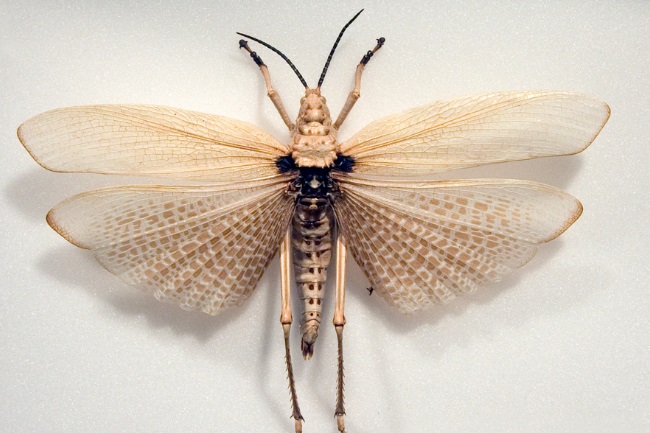
Flying has pros and cons compared to hopping, you can go further, but it’s slower, making the escapee vulnerable, particularly to aerial attack. Some particularly good fliers, like bird grasshoppers, use their flying abilities to escape up into trees, making them inaccessible to many predators.
Making noise
Grasshoppers are well known for their evening serenades; however some species also choose to use sound to escape becoming dinner. These grasshoppers can make clacking noises with their wings as they fly. This buzzing sound is often used as part of the mating ritual but also to put off chasing enemies wanting a bite.
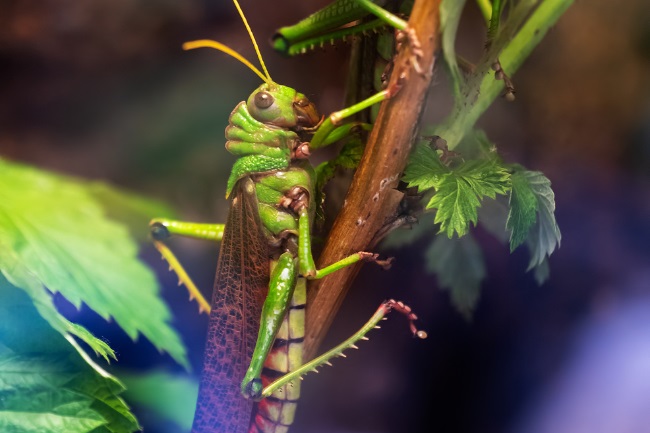
Aside from an aerial clattering, grasshoppers can also make a kind of chirrup with their mouths. This might not seem very intimidating to us, but it can surprise a hungry bird or frog enough to give the grasshopper a second to escape.
Also read: Do Grasshoppers Make Noise? (Sound Production Explained)
Camouflage
Arguably many grasshoppers’ most valuable defence mechanism is to never be found in the first place. Because they spend most of their time sat in the grass they camouflage by being prominently green, yellow and brown in colour. Some have stripes up and down their bodies, this breaks up the colour helping them to blend in even more, among the light and shadow.
Bright colours
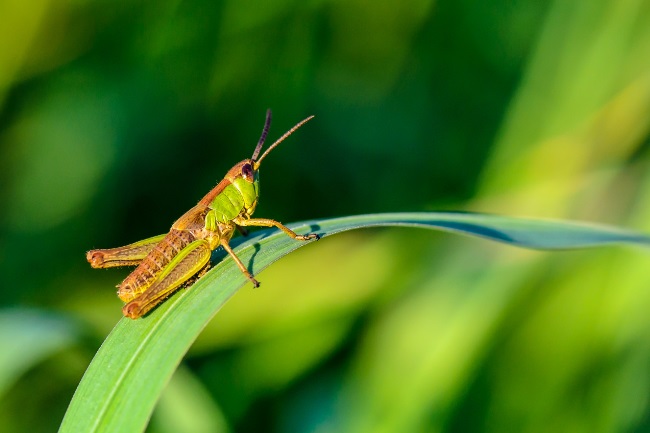
Although many grasshoppers utilise camouflage, some go the opposite way and use bright colours to surprise, alarm and warn predators. A common technique is to have brightly coloured wings. This means that they can flash these colours are they fly away, which can startle their presuer.
Being poisonous
Hand in hand with bright warning colours, comes the poisons to back up the threat. Many herbivores have adapted to cope with toxins manufactured by the plants aimed at preventing them from being eaten. As well as being able to eat the toxins, many insects also accumulate them in their body, meaning they become poisonous to anything trying to eat them. Warning colours like bright reds, yellows and oranges, can tell any possible eater that they are not worth the trouble.
Biting
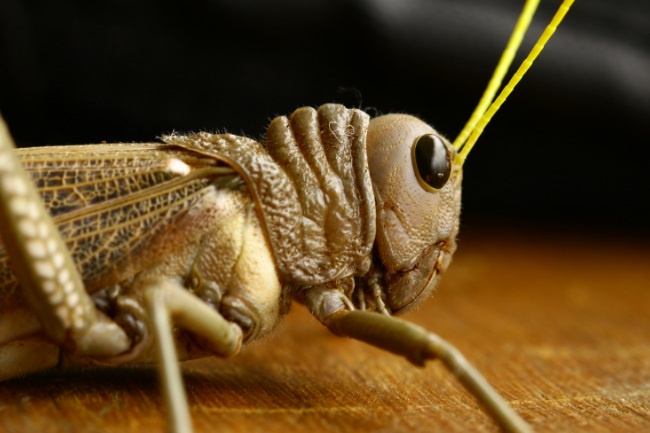
Given their size and the size of most of their predators, a grasshopper’s bite isn’t much of a defence mechanism. However a quick nip to an exploring finger, can be enough of a shock to allow the little invertebrate get away.
Kicking
While grasshoppers are famous for their hop, they don’t have a strong enough kick to do any damage. However, as well as larger predators, many invertebrates are happy to munch down on a grasshoppers, from ants to wasps to spiders. While a bird beak won’t give up because of a kick, it might be enough to flick an exploring ant off its perch.
Losing a limb, or two
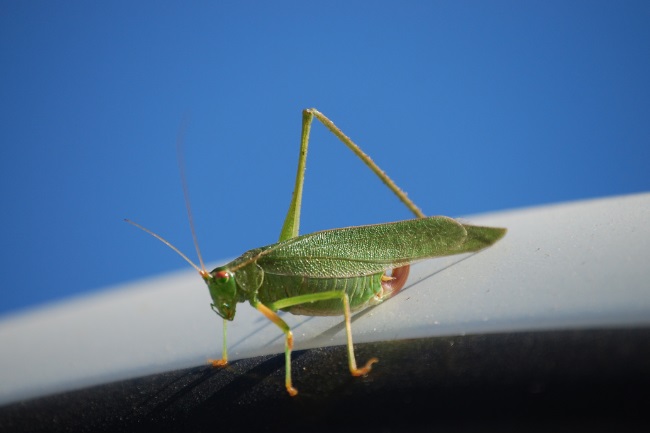
Survival is certainly a brutal thing at times. Sometimes when the choice is between loosing your life or losing a limb then the lesser of the two evils is to be a little legless. Grasshoppers have the ability to drop one or both of their back legs if needed. This certainly isn’t something to be done lightly, as their life is pretty challenging with fewer legs to hop around on. Yet, even with three legs rather than four at least they live in limp on another day.
Also read: Do Grasshopper Legs Grow Back? (Regeneration Explained)
Spitting
Some species of insect produce foul tasting liquids when threatened, so as to put off their foe. Grasshoppers sometimes produce something called tabacco spit, a sour tasting brown liquid made up of stomach acid and partly digested grass. As unpleasant flavours are often associated with poisons, many animals will give up, thinking the grasshopper will make them ill.
The chance to live another day
The grasshopper’s survival kit might not be as dramatic as that of a viper or lion, but they certainly do have a few tricks up their sleeves to get out of hot water as best they can. Yet, in the end, it’s still a lot to do with luck. If a hungry bird swoops down from above there’s little a little grasshopper can do. Luckily one female grasshopper can lay hundreds and hundreds of eggs, otherwise there might not be any grasshoppers left at all.

